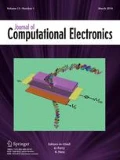Abstract
We calculate the energy dispersion relations in Si quantum wells (QW), E(k 2D), and quantum wires (QWR), E(k 1D), focusing on the regions with negative effective mass (NEM) in the valence band. The existence of such NEM regions is a necessary condition for the current oscillations in ballistic quasineutral plasma in semiconductor structures. The frequency range of such oscillations can be extended to the terahertz region by scaling down the length of structures. Our analysis shows that silicon is a promising material for prospective NEM-based terahertz wave generators. We also found that comparing to Si QWRs, Si QWs are preferable structures for NEM-based generation in the terahertz range.
Similar content being viewed by others
References
Gribnikov, Z.S., et al.: Quantum real-space transfer in a heterostucture overgrown on the cleaved edge of a superlattice. J. Appl. Phys. 93(1), 330 (2003)
Gribnikov, Z.S., et al.: Negative-effective-mass ballistic field-effect transistor: Theory and modeling. J. Appl. Phys. 87(10), 7466 (2000)
Boykin, T.B., et al.: Valence band effective-mass expressions in the sp 3 d 5 s ∗ empirical tight-binding model applied to a Si and Ge parametrization. Phys. Rev. B 69(11), 115201 (2004)
Rahman, A., et al.: Atomistic approach for nanoscale devices at the scaling limit and beyond – valley splitting in Si. Jpn. J. Appl. Phys. 44(4B), 2187 (2005)
Gribnikov, Z.S., et al.: Terahertz ballistic current oscillations for carriers with negative effective mass. J. Appl. Phys. 80(10), 5799 (1996)
Schmid, U., et al.: Relativistic band structure of Si, Ge, and GeSi: Inversion-asymmetry effects. Phys. Rev. B 41(9), 5919 (1990)
The sp 3 d 5 s ∗ model includes spin and spin-orbital coupling explicitly. These simulations do not include any external magnetic field that would provide spin selection. The splitting of the states is purely due to symmetry breaking and the two split states are a mixture of up and down spins
Author information
Authors and Affiliations
Corresponding author
Rights and permissions
About this article
Cite this article
Mitin, V., Vagidov, N., Luisier, M. et al. EnergyDispersion Relations for Holes in Silicon Quantum Wells and Quantum Wires. J Comput Electron 6, 227–230 (2007). https://doi.org/10.1007/s10825-006-0103-9
Published:
Issue Date:
DOI: https://doi.org/10.1007/s10825-006-0103-9




